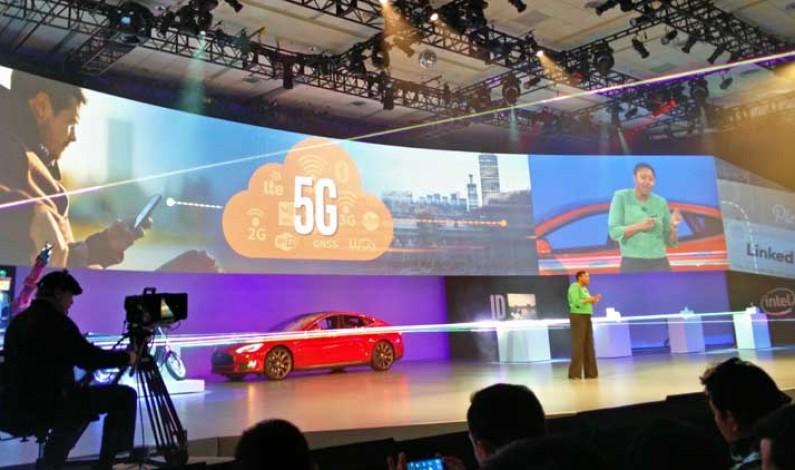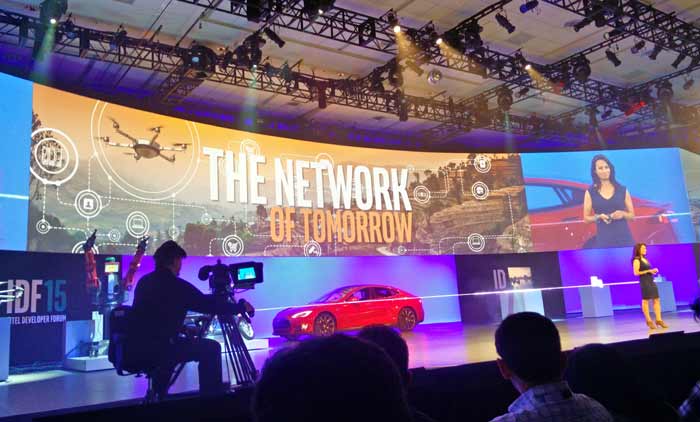We still be contemplating the advent of 4G, but in many parts of the world the chatter has moved up a notch to 5G. One thing that was clear from a session on 5G technologies at the Intel Developer Forum in San Francisco was we should not start assuming that 5G would mean just faster Internet, it will be much more. And in that sense it will be game changing. Or should we say life changing?
Here is a look at what the 5G world will be like, or should be like.
Let us start by defining what is 5G? For the consumer it will mean ultra high data speeds, ultra low latency and new devices and form factors. But behind all this will be mobile edge computing with serious processing power being added on the base stations. That will be crucial, because 5G will be a network transformation in more ways than one.
[youtube width=”800″ height=”500″]https://www.youtube.com/watch?v=GFRGIx0dEPU[/youtube]
Intel executives used the Intel Developer Forum (IDF) 2015 to describe a 5G world where drones and balloons will connect the unconnected, and consumers won't need to be concerned whether it's Wi-Fi or 4G — everything will just work seamlessly like on big network, including things like cars, scooters and refrigerators.
Techniques like software-defined networking (SDN) and network functions virtualization (NFV) also will enable the creation of a centrally managed network, executives said.
An Introduction to 5G:
Short animated video to introduce a presentation about the upcoming 5G mobile data network and the Internet of Things.
[youtube width=”800″ height=”500″]https://www.youtube.com/watch?v=WfD9ch1sVGU[/youtube]
What is 5G?
To understand 5G you have to get an idea of the narrative the telecoms industry has created. According to this, a G (generation) is what happens every ten years – starting in the 1980s: 1G was analogue voice, 2G is digital voice, 3G is mobile internet access, and 4G is mobile video.
Intel’s vision – as revealed last week – aligns with a broadly shared vision within the industry. This vision includes improvements to the current mobile broadband offering such as higher speeds and greater capacity on the networks. More interestingly, it also includes other characteristics such as low latency, ultra-reliability, and low cost chipsets.
Latency is the delay present in the network, such as the one you can sometimes perceive in applications like Skype. If this can be brought down to levels that are brushing up against the limitations of the fundamental laws of physics, then interacting through a wireless network would effectively be equivalent to direct physical interaction.
If your car’s mobile connection has a low enough latency, then it may be just as safe to drive your children home from school remotely, as it is from behind the wheel. Equally, a surgeon could treat patients from hundreds of miles away.
Bringing the cost of wireless connections down could also allow the mass deployment of wireless chips in to every conceivable item. This is why Ericsson often talks of the “Internet of Everything”. In this scenario, machines are not only receiving instructions from human, but are talking amongst themselves. If every car had a 5G connection, then your car could learn about road conditions by receiving information from other cars.
Higher data rates — at least 100 times and sometimes 1,000 times higher – along with ultra-low latency and significantly different form factors are some of the key features of 5G, according to Choi. Virtual reality and augmented reality have been around for a while, but 5G will bring added benefits. Real-time, ultra HD video streaming is another piece that 5G promises.
McNamara said the 4G economy was largely driven by video, and the 5G economy largely will be driven by the Internet of Things (IoT). When you start to think about IoT use cases, "imagine that I'm driving in my car and the network detects that one second in front of me, there was a sudden deceleration and airbags were deployed," he said. "The network has 20 milliseconds to send my car a message that says I need to apply the brakes. At that very same instant, my connected toaster detects that the crumb tray is full. Those two things are very, very different and they need very, very different sorts of network characteristics."
Everything You Should Know About 5G!
[youtube width=”800″ height=”500″]https://www.youtube.com/watch?v=ikR0_ptc4P4[/youtube]
Wearables are another key component. Rivera predicts that at least some percentage of people will want chips implanted in their body, according to Re/code. Choi also said some sensors may become part of the body itself. "Anyone can be a Terminator," he said.
Intel also introduced the Intel Network Builders Fast Track, a program comprised of market development activities and Intel Capital investments that's designed to accelerate network innovation and interoperability. And it announced a number of industry collaborations, including with Nokia Networks (NYSE:NOK), NTT DoCoMo and SK Telecom, as well as academic institutions and others to accelerate 5G standards development.
Intel's interest in 5G and the IoT isn't surprising given that last year, it unveiled a new Intel IoT platform designed to serve as an end-to-end reference model for unifying and simplifying connectivity and security for IoT.
H/T: fiercewireless.com
[divider scroll_text=”Back To Top”]


